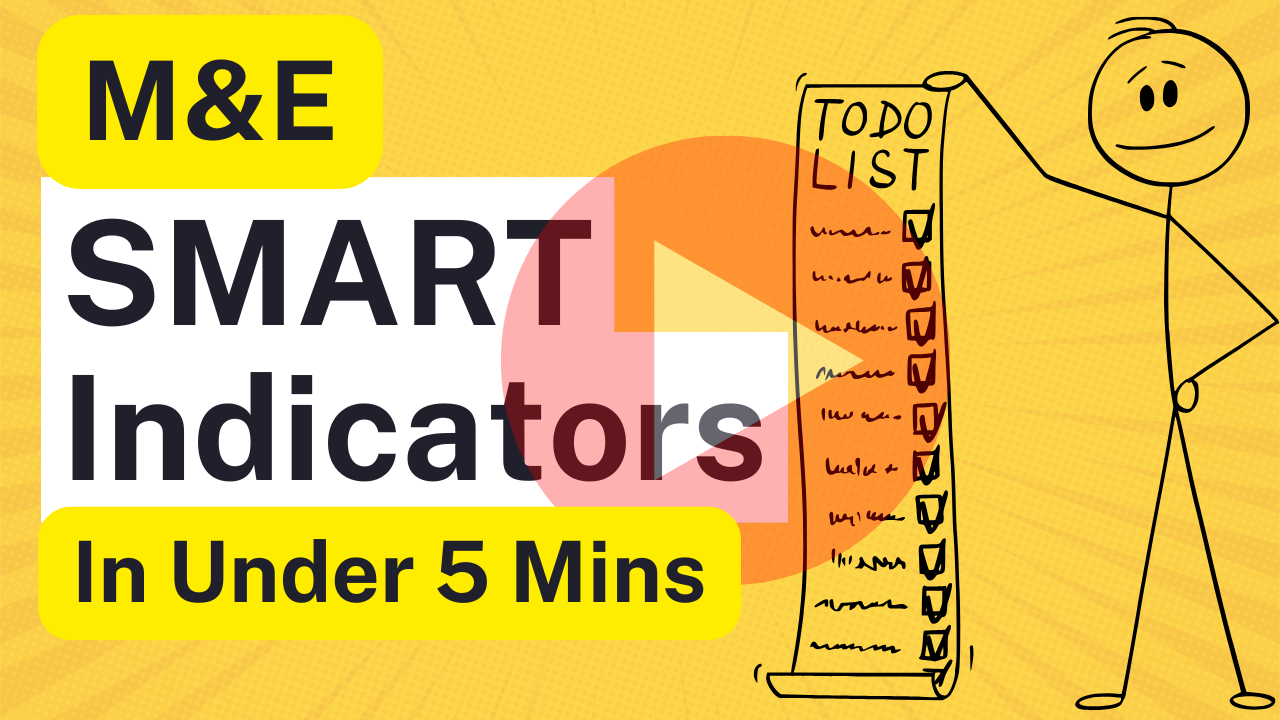Understanding Key Concepts in M&E
December 19, 2023 2023-12-19 11:51Understanding Key Concepts in M&E
If you work with programs, Monitoring and Evaluation (M&E) is crucial to their success. To assess and enhance your programs, you must have a solid grasp of the Key Concepts in M&E. Not only does this ensure that you can analyze and improve program outcomes, but it also helps you to communicate the value of your work to both funders and beneficiaries.
Throughout this article, we’ll dive into the essential concepts of M&E so that you’re better equipped to design, implement, and evaluate programs. These topics include:
- The Logical Framework (Logframe)
- Indicators and Targets
- Outcome Evaluation and Impact Evaluation
- Performance Monitoring and Data Collection Methods
- Theory of Change and Stakeholder Analysis
- Results-Based Management (RBM) and Process Evaluation
- Cost-Benefit Analysis and Sustainability Assessment
- Participatory Evaluation and Logical Model
Key Takeaways
- Understanding M&E is essential to the success of programs.
- The Logical Framework and Indicators are fundamental for effective design and evaluation.
- Outcome Evaluation and Impact Evaluation help measure program effectiveness and long-term impact.
- Performance Monitoring is an ongoing process that involves collecting and analyzing data to track progress towards program objectives.
- Theory of Change and Stakeholder Analysis contribute to effective program planning and evaluation.
The Logical Framework (Logframe)
The Logical Framework, also referred to as the Logframe, is an effective planning and management tool utilized in M&E. By implementing the Logframe, you can clearly identify the desired outcomes and identify the activities needed to achieve them, ensuring a structured approach to program design and evaluation. This approach guarantees that critical elements such as indicators, targets, and assumptions are precisely defined, giving you an accurate assessment of program effectiveness.
The Logframe defines how a program’s components fit together to achieve its goals, providing a system for measuring achievements and possible constraints. It also assists in reporting and communicating program progress and achievements to key stakeholders. By developing a strong Logframe, you provide transparency and support for your program’s mission, vision, and objectives, allowing you to demonstrate a clear path toward success.
Indicators and Targets
When evaluating a program, it’s crucial to have measurable variables to assess progress and performance. That’s where indicators come in. Indicators provide evidence of a program’s effectiveness and track the achievement of specific objectives. Targets, on the other hand, are the desired levels of performance that the program aims to achieve.
When selecting indicators, it’s essential to choose ones that are relevant to the program and provide valuable insights. For example, if you are evaluating a nutrition program, relevant indicators might include the number of participants who meet their daily recommended nutrient intake or the reduction in instances of malnutrition.
Setting appropriate targets is just as important. Unrealistic targets can lead to disappointment and frustration, while low targets may not challenge the program sufficiently. Targets should be specific, measurable, achievable, relevant, and time-bound (SMART).
Ultimately, selecting appropriate indicators and setting realistic targets will help you to accurately assess the effectiveness of your program and track its progress towards achieving your goals.
Outcome Evaluation and Impact Evaluation
When evaluating the effectiveness and impact of a program, it is essential to distinguish between outcome evaluation and impact evaluation. Outcome evaluation assesses the immediate and intermediate outcomes of a program, while impact evaluation examines the broader social or economic changes resulting from program implementation.
Outcome evaluation is typically conducted during program implementation to track progress towards achieving program objectives. It provides insight into the effectiveness of program activities, identifies areas for improvement, and informs program decision-making.
Impact evaluation, on the other hand, examines the longer-term effects of a program and its contribution to broader social or economic changes. Impact evaluation often involves comparing the outcomes of program participants to non-participants or measuring changes over time in the target population.
While both outcome evaluation and impact evaluation are valuable in assessing program effectiveness, they have different benefits. Outcome evaluation is useful for identifying areas for improvement during program implementation, while impact evaluation provides a broader perspective on program impact and helps demonstrate program effectiveness to stakeholders.
Differences between Outcome Evaluation and Impact Evaluation
| Outcome Evaluation | Impact Evaluation |
|---|---|
| Assesses immediate and intermediate program outcomes | Examines broader social or economic changes resulting from program implementation |
| Conducted during program implementation | May be conducted after program completion |
| Provides insight into program effectiveness and areas for improvement | Demonstrates program impact to stakeholders |
To ensure that both outcome evaluation and impact evaluation are effective, it is essential to identify appropriate indicators for evaluation, collect relevant data, and consider contextual factors that may impact program effectiveness. By employing both approaches, you can gain a comprehensive understanding of program effectiveness and contribute to its ongoing improvement.
Performance Monitoring and Data Collection Methods
Once your program has been designed and implemented, performance monitoring is essential to ensure that your objectives are being met. This ongoing process involves collecting and analyzing data to track progress and identify areas for improvement.
There are several data collection methods that you can use to monitor the performance of your program, including:
| Method | Description | Strengths | Limitations |
|---|---|---|---|
| Surveys | A series of questions asked to a group of people to gather specific information about their experiences or opinions. | Large sample sizes, quantitative data, standardized information. | Potential for bias, limited range of responses, not suitable for in-depth analysis. |
| Focus groups | A facilitated group discussion to gain qualitative insights on a specific topic or issue. | Provides in-depth insights, gathers diverse perspectives, flexibility in questions asked. | Small sample size, potential for groupthink or peer pressure, difficult to analyze. |
| Observation | Systematic recording of behavior, processes, or conditions in a naturalistic setting. | Unobtrusive, captures actual behavior rather than self-reported behavior. | Subjectivity in interpretation, potential for observer bias, not suitable for capturing internal thoughts or feelings. |
When deciding which data collection method to use, you should consider the nature of your program and the type of information you hope to gather. For example, if you are interested in measuring changes in knowledge or behavior, surveys may be a more appropriate method, whereas if you want to understand the experiences or perceptions of program participants, focus groups may be more suitable.
Remember that the choice of method will impact the quality and relevance of your data, which will ultimately impact the effectiveness of your program.
It is important to note that data collection is only the first step in performance monitoring. Once data has been collected, it must be analyzed to provide actionable insights and inform program decision-making. This analysis should be ongoing and should be used to continually improve the program over time.
Theory of Change and Stakeholder Analysis
To achieve your program’s intended outcomes, it is crucial to have a clear understanding of the causal pathways that underpin them. This is where the theory of change comes in handy. It provides a roadmap of the expected results and the steps needed to attain them.
Stakeholders play a critical role in your program’s success. They are the individuals or groups who are interested in or have an influence over your program. By identifying and engaging these stakeholders, you can gain valuable insights into program needs and develop partnerships that can help achieve your goals.
“The stakeholder analysis helped us understand who had the most significant impact on our program and allowed us to develop tailored strategies to engage them.” – Jane Smith, Program Manager
Integrating the theory of change and stakeholder analysis into your program planning and evaluation can help you stay focused on your goals and make informed decisions about how to achieve them.
Results-Based Management (RBM) and Process Evaluation
Results-Based Management (RBM) is a program management approach that emphasizes the importance of achieving measurable results. To implement RBM, you need to define clear goals and objectives, identify the activities required to achieve them, and measure progress towards these goals through performance indicators (as discussed in Section 3). By adopting an RBM approach, you can ensure that your programs are evidence-based and aligned with the overall strategic goals.
Process evaluation is a type of evaluation used to assess the implementation process of a program. It involves examining the delivery of the program and identifying areas for improvement. A process evaluation can help you identify factors that may constrain or facilitate program implementation, such as resource constraints, staffing, training needs, or other factors. By conducting a process evaluation, you can optimize the implementation of your program and improve its chances of success.

“Results-based management is a shift from activity-based management to results-based management. It is a way of thinking, planning, managing, and reporting that is results-oriented and that involves performance measurement and learning.” – Government of Canada
Cost-Benefit Analysis and Sustainability Assessment
When evaluating the effectiveness of a program, it’s not enough to just look at the immediate outcomes. That’s where cost-benefit analysis and sustainability assessment come in.
Cost-benefit analysis is a powerful tool for assessing the economic efficiency of a program. By comparing the costs and benefits associated with the program, you can determine whether it’s a worthwhile investment. This analysis takes into account all expenses associated with the program, including staff salaries, equipment, and other resources, and compares them to the expected benefits, monetizing them whenever possible. A positive net present value shows that the benefits outweigh the costs, making the program a good investment.
On the other hand, sustainability assessment examines the long-term viability and impact of a program. A program that is successful in the short-term may not be sustainable in the long-term. Sustainability considers the program’s social, economic, and environmental impacts, as well as the resources it requires to continue running. By assessing sustainability, you can ensure a program’s continued success and impact beyond its initial implementation, avoiding negative unintended consequences that could harm the community or environment.
The Importance of Cost-Benefit Analysis and Sustainability Assessment
Cost-benefit analysis and sustainability assessment are essential components of program evaluation. By completing these assessments, you can be confident that your program is not only effective but also efficient and sustainable. An effective program with a negative financial return or negative long-term impact is not a good investment of resources and could have negative consequences.
Moreover, cost-benefit analysis can help justify continued funding, ensuring the availability of resources for future success. Sustainability assessment ensures that the program does not harm beneficiaries, environmental resources or undermine future success by overtaxing the limited resources.
Implementing cost-benefit analysis and sustainability assessment in your M&E plan will help you create programs that are effective, efficient and sustainable.
Participatory Evaluation and Logical Model
Participatory evaluation is an approach to M&E that involves actively engaging program participants and other stakeholders in the evaluation process. By involving those who are directly affected by the program, participatory evaluation can provide a more comprehensive and nuanced understanding of the program’s impact. This approach can also improve the program’s relevance, effectiveness, and sustainability.
One benefit of participatory evaluation is that it can provide a more nuanced understanding of program impact. When participants are involved in the evaluation process, they can provide feedback on what works and what doesn’t, and suggest program modifications that could improve program outcomes. Because of this, participatory evaluation can yield more meaningful and actionable findings.
Another tool that can be used in M&E is the logical model. A logical model provides a visual representation of the inputs, activities, outputs, and outcomes of a program, and the relationship between them. By mapping out the relationships between these different components, the logical model can help to identify effective strategies for program design and evaluation.
By using a logical model in M&E, you can clearly see how your program is expected to work, what outputs and outcomes you need to track, and how you can measure your program’s success. The logical model provides a clear and explicit framework for understanding program design, laying out the expected pathway from program inputs to desired program outcomes.
The Benefits of Participatory Evaluation:
- More comprehensive and nuanced understanding of program impact
- Improved program relevance, effectiveness, and sustainability
- Increased stakeholder buy-in and support
- Generation of more meaningful and actionable findings
Elements of a Logical Model:
| Element | Description |
|---|---|
| Inputs | The resources, personnel, and materials required for program implementation |
| Activities | The actions and strategies taken to achieve program objectives |
| Outputs | The immediate results of program activities |
| Outcomes | The longer-term objectives and impact of the program |
By incorporating participatory evaluation and logical models into your M&E strategy, you can ensure that your programs are designed and evaluated in a thorough and effective manner. These approaches can improve program relevance, effectiveness, and sustainability, and provide meaningful and actionable findings that can guide program improvement and decision-making.
Conclusion
Now that you have a better understanding of the key concepts in M&E, you can start using these tools to enhance the effectiveness of your programs. Remember that by utilizing the logical framework and selecting appropriate indicators and targets, you can track your progress and evaluate your outcomes and impact.
It’s important to also consider the differences between outcome evaluation and impact evaluation, and to use the most appropriate data collection methods to monitor program performance.
By incorporating the theory of change and stakeholder analysis into your planning process and applying the principles of results-based management, you can ensure that your programs are well-designed and sustainable over the long-term.
Participatory evaluation can also provide valuable insights and help ensure that your programs are meeting the needs of your stakeholders. Finally, don’t forget to use cost-benefit analysis to assess the economic efficiency of your programs and evaluate their sustainability beyond the initial implementation.
By following these guidelines, you can be confident that your programs are making a positive impact and contributing to meaningful change.
FAQ
What is the Logical Framework (Logframe)?
The Logical Framework, also known as the Logframe, is a planning and management tool used in Monitoring and Evaluation (M&E). It helps to identify the desired outcomes and the activities required to achieve them. The Logframe provides a structured approach to program design and evaluation, ensuring that key elements such as indicators, targets, and assumptions are clearly defined.
What are indicators and targets in M&E?
Indicators are measurable variables used to assess the progress and performance of a program. They help to track the achievement of specific objectives and provide evidence of program effectiveness. Targets, on the other hand, are the desired levels of performance that the program aims to achieve. It is important to select appropriate indicators and set realistic targets to effectively measure program outcomes and impact.
What is the difference between outcome evaluation and impact evaluation?
Outcome evaluation focuses on the immediate and intermediate outcomes of a program, while impact evaluation examines the long-term effects and broader social or economic changes resulting from the program. Both evaluation methods are valuable for assessing program effectiveness. Outcome evaluation provides insights into the immediate outcomes achieved, while impact evaluation assesses the program’s long-term impact on the target population or broader society.
What are the different data collection methods used in M&E?
M&E utilizes a range of data collection methods, including quantitative and qualitative approaches. Quantitative methods involve numerical data collection through surveys, questionnaires, and analysis of existing data. Qualitative methods involve gathering in-depth insights through interviews, focus groups, observations, and case studies. Choosing the most appropriate data collection method is crucial to capture relevant information and generate meaningful findings for program assessment and improvement.
What is the Theory of Change and Stakeholder Analysis in M&E?
The Theory of Change is a conceptual framework that outlines the causal pathways through which a program is expected to achieve its intended outcomes. Stakeholder analysis involves identifying and engaging key individuals or groups who have an interest in or influence over the program. Both concepts contribute to effective program planning and evaluation by providing a clear understanding of how the program is supposed to work and who needs to be involved.
What is Results-Based Management (RBM) and Process Evaluation?
Results-Based Management (RBM) is an approach to program management that focuses on achieving measurable results. It emphasizes setting clear objectives, designing interventions based on evidence and assessing performance against pre-defined indicators. Process evaluation involves assessing the implementation and delivery of a program to identify areas for improvement. RBM and process evaluation are essential components of effective M&E and help ensure that programs achieve their intended outcomes.
What is Cost-Benefit Analysis and Sustainability Assessment in M&E?
Cost-Benefit Analysis is a technique used to assess the economic efficiency of a program by comparing the costs and benefits associated with its implementation. Sustainability assessment, on the other hand, examines the long-term viability and impact of a program beyond its initial implementation. Both concepts are important in ensuring the long-term success of programs, as they help identify the economic feasibility and potential for continued positive outcomes.
What is Participatory Evaluation and Logical Model in M&E?
Participatory evaluation involves engaging program participants and other stakeholders in the evaluation process. By involving stakeholders, including beneficiary groups and communities, in the evaluation, the findings are often more meaningful and actionable. A logical model, also known as a program theory or program logic, is a visual representation of the relationships between program inputs, activities, outputs, and outcomes. It helps stakeholders understand the logic behind the program and support decision-making in M&E.





